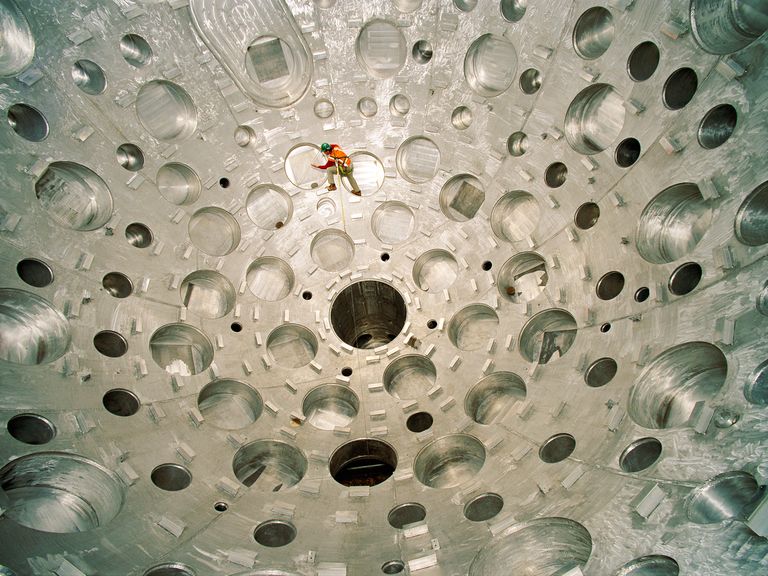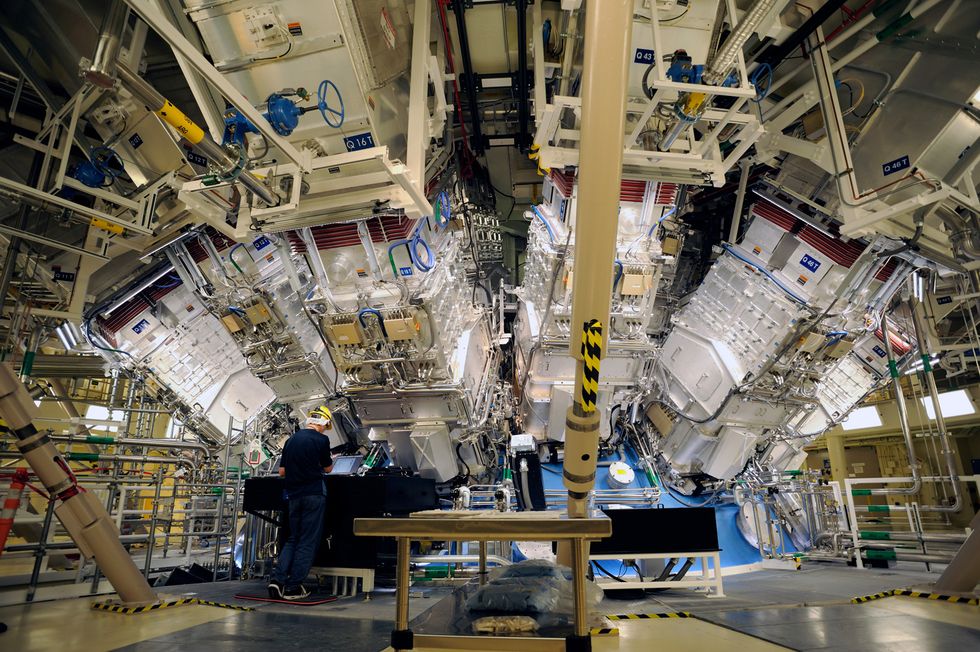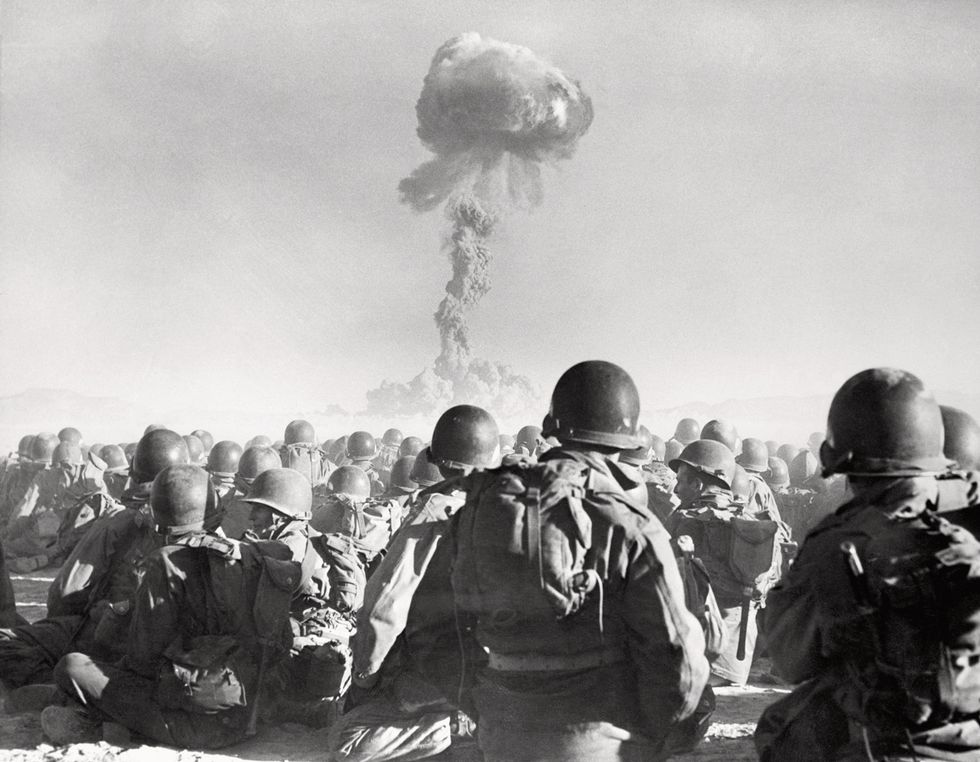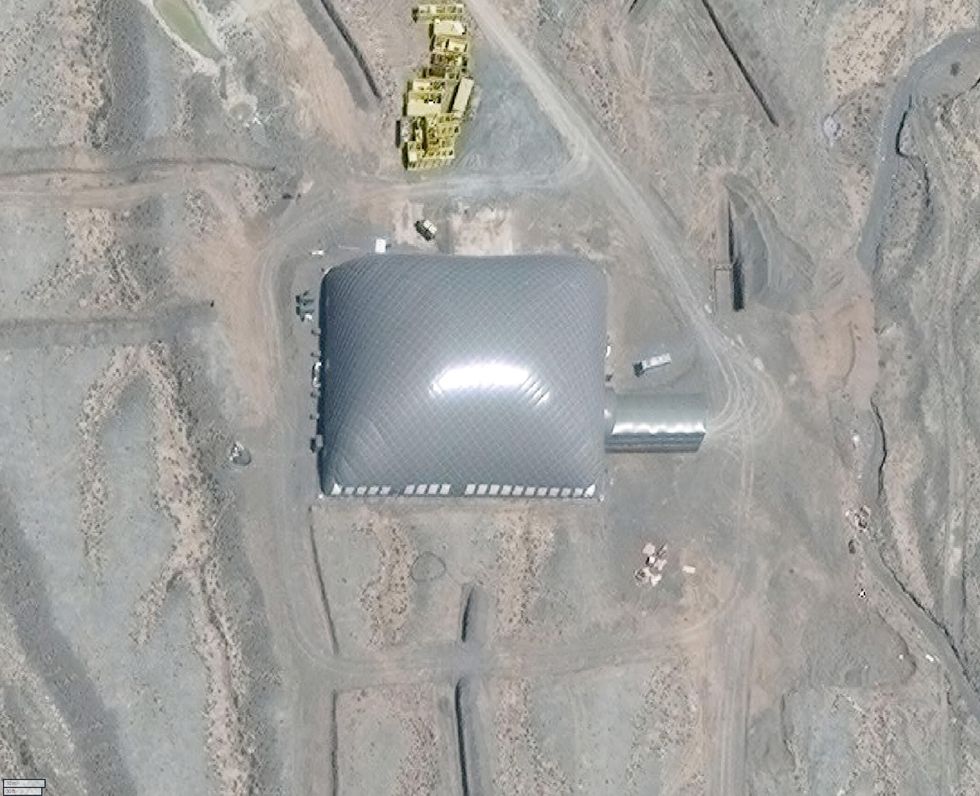One-foot-thick concrete doors lead to the central target chamber of the National Ignition Facility (NIF), a $3.5 billion research center dedicated to studying nuclear weapons. The mazelike facility is loud with the sound of whirring fans, banging equipment, and, on occasion, beeping signals. Each of the gigantic doors has been covered with concrete injected with boron, an element known for its ability to absorb high-energy neutrons that come blasting out of the chamber as a result of the explosive experiments taking place there.
Because of its shape, the three-story-tall central target chamber conjures images of the Death Star. But that’s from the wrong movie. “If this looks familiar to you,” says theoretical chemist Heather Whitley, the NIF’s associate program director for high-energy-density science, “it could be because you saw Star Trek Into Darkness.” Filmmakers used the chamber, which is surrounded by snaking pipes and intricate electronic sensors, as a stand-in for the Starship Enterprise’s warp core.
The NIF is far more than just the world’s most expensive movie prop. The central target chamber is situated between two football-field-size buildings on the grounds of the Lawrence Livermore National Lab in Northern California. The enormous blue sphere contains the world’s largest and most powerful laser. Scientists can focus 192 individual ultraviolet laser beams onto targets no bigger than peppercorns. The targets implode with the force of a miniature nuclear blast. When this happens, for a fraction of a second, the target becomes the hottest place in the solar system, with temperatures exceeding 100 million degrees Fahrenheit and pressures 100 times denser than lead.
The only facility capable of conducting such experiments, the NIF has allowed scientists to pioneer fusion energy, investigate conditions in the bellies of stars, and answer questions about the complex physical processes that occur when a nuclear warhead goes off. That data has become all the more critical now that the Navy, Department of Defense, and the Deparment of Energy’s National Nuclear Security Administration (NNSA) are planning to build a new warhead, called the W93. (Nuclear weapons are named for the order in which they are conceived, making this the 93rd design considered by the United States.) This will be the first new nuclear weapon in more than thirty years—and it will be the first that scientists have ever built without the capability of testing it. That’s because since 1996, the United States has participated in a near-worldwide Comprehensive Test Ban Treaty that prohibits the detonation of a nuclear warhead anywhere in the world for military or scientific purposes.
Development of the W93 is expected to cost roughly $15 billion, and the warhead should be ready to deploy sometime in the next decade. The program was first announced in 2020 during the Trump Administration, and its preliminary design studies are due to be completed this October. Which means the United States has now entered into its first new nuclear weapons project since the end of the Cold War.
Officials feel assured that decades of research and simulations will allow them to produce the warhead without too much trouble. “We have learned so much about how the actual weapons work through these computer models and experiments,” says Frank Rose, the principal deputy administrator of the NNSA. “We have a high degree of confidence that we can design, build, and maintain this new W93 warhead without resorting to new explosive nuclear testing.”
But not everyone is convinced, especially given that things almost invariably work differently in reality than in models. “I find it enormously concerning,” says Geoff Wilson, a policy analyst with the Center for Arms Control and Non-Proliferation. “I’m sure that folks from the national laboratories will say, ‘Oh, we test these things all the time.’ And I’m sure that they are incredible simulations.” Yet military programs for things such as new fighter jets are often delayed and run over budget because engineers discover that their components did not work as they had originally been designed. So, Wilson says, “the question of testing is a real one.”
Depending on its design, a nuclear warhead is between 5- and 12-feet long and typically has a conical shape. Most explosions are caused by chemical reactions, in which some kind of activation energy—say, lighting the fuse on a stick of dynamite—breaks the existing chemical bonds between atoms and causes the electrons on the outside of atoms to rearrange themselves. As these atoms break apart and form new chemical bonds, the process releases energy in the form of heat and gas, which expands rapidly in what we know as an explosion.
In nuclear weapons, however, you’re not just breaking bonds among atoms, but within them. In fission, the protons and neutrons in the nucleus of an atom break apart (hence the phrase “splitting the atom”). The force of attraction between protons and neutrons is many orders of magnitude greater than that between electrons and the nucleus, which is why fission creates such a powerful explosion.
The first deployed nuclear bomb—Little Boy, dropped on Hiroshima—used the process of fission to generate an explosion. In order to break the powerful natural bonds between protons and neutrons, you need to start with what is known as fissionable material, isotopes that can be bombarded with neutrons, absorb them, become unstable, and split. This sets off a chain reaction and massive explosion.
Within seven years after Hiroshima, researchers had updated nuclear warheads to incorporate fusion as well as fission, resulting in a potentially even more devastating blast. The newer weapon explodes in two stages: First, a conventional explosive crushes a hollow sphere of plutonium to a critical density, causing fission. Through a series of steps, the energetic X-rays emitted during the first stage allow isotopes of hydrogen called deuterium and tritium in the second stage to overcome their natural electrostatic repulsion and fuse together, releasing colossal amounts of energy and additional neutrons that boost the fission explosion. For this reason, these weapons were dubbed hydrogen bombs.
The first hydrogen bomb test, detonated on the Eniwetok Atoll in the Marshall Islands in 1952, released an explosion equivalent to seven hundred Hiroshima blasts. The W76 and W88 warheads currently deployed on U.S. subs are a bit more scaled back; they have the power of “only” six and twenty-eight Hiroshima blasts, respectively.
The early live tests of nuclear weapons served several purposes. The 1945 Trinity test, the first ever conducted, was necessary for scientists to know that their new device would actually work as planned, and it also gave them their first look at the effects of a nuclear blast. When it went off, the blast released a force equivalent to 18,600 tons of dynamite, fusing sand in the New Mexico desert into glass and, according to observers, lighting up the sky “like the sun.”
The United States has conducted 1,053 subsequent nuclear tests, with various degrees of destruction. These were mainly done to gain a better understanding of different weapons designs, how powerful each would be, and whether nuclear weapons could be used in conjunction with soldiers on a battlefield.
Though most warheads were detonated in remote areas such as islands and deserts, live testing was still incredibly damaging to people and the environment. The 1954 Bravo test on Bikini Atoll, in the Marshall Islands, ended up being nearly three times larger than physicists had predicted, and the consequences were far-reaching. Radiation poisoning affected not only the crew of a Japanese fishing vessel near the fallout zone but also residents of Rongelap and Utirik, a pair of atolls 100 and 300 miles to the east, respectively. Such powerful tests left many islands uninhabitable and produced radioactive fallout that lingered in the atmosphere for long periods of time.
In the 1960s, studies showed that throughout the U.S. and the world, children’s baby teeth contained 50 times the normal level of radioactive strontium-90, a byproduct of the warheads, increasing their risk of bone cancer. For these reasons, the United States moved to underground testing in 1963, where the explosions could be contained in deep holes and monitored with scientific instruments. Even then, underground tests led to contamination of soil and groundwater and vented radiation into the atmosphere, where it was often carried away on winds.
The last U.S. nuclear test, known by its codename Divider, occurred on September 23, 1992, though at the time nobody knew it would be the nation’s final live test. Spurred by lobbying from disarmament groups, Congress passed a temporary moratorium on nuclear weapons tests in June 1993. The U.S. permanently stopped live testing a few years later when it joined most nuclear nations in signing the Comprehensive Test Ban Treaty.
In spite of the fact that the U.S. hasn’t blown up any nuclear warheads in more than three decades, military experts are confident that the W93 can be trusted to go off as planned. Data gathered from more than a thousand live atomic tests that occurred before the ban went into place is stored in classified magnetic tapes at Lawrence Livermore Labs. It serves as the basis of complex supercomputer simulations that can explore the processes of a nuclear explosion in fine detail. These are conducted under the Stockpile Stewardship Program, an initiative run out of Livermore and other weapons labs across the United States that is tasked with determining how our existing arsenal ages over time.
Predicting how a nuclear warhead will perform when detonated requires understanding the material properties of plutonium, one of the strangest and most enigmatic elements on the periodic table. Plutonium is what is known as a fissile material, an element that is capable of undergoing reactions where atoms split apart, and it is used in the core of nuclear warheads. It is also an element so rare in nature that the amounts needed for an atomic bomb must be manufactured. Plutonium’s scarcity is also the reason we don’t know much about how it changes or degrades over time—information that’s vital to ensuring that our current atomic arsenal isn’t full of duds.
There is some debate as to whether the hollow plutonium cores of warheads that power the explosion, known as pits, need to be regularly switched out for newer pits. An independent assessment in 2007 from the scientific advisory group JASON concluded that the W76’s and W88’s plutonium cores should be good for at least a century. A 2012 study from Livermore backed up these findings, identifying no unexpected aging issues for 150 years, though it advocated for further research to understand the pit aging process.
Government officials disagree. “You can’t make a blanket statement like, ‘Pits are good for 80 to 100 years,’” says Marvin Adams, a nuclear engineer and the NNSA’s deputy administrator for defense programs. “It depends on the system, and it depends on the environment. Anything we say about a lifetime of 80 to 100 years is an extrapolatory statement. We’ve never seen 100-year-old plutonium, right? We started making it in the [19]40s.”
At the NIF, scientists have studied how plutonium responds to different extremes of temperature and pressure, which gives them a better idea of how it might age inside a warhead. Other experiments provide insight into how energy flows out of a nuclear detonation, or whether a warhead exposed to radiation, say from an enemy warhead, might still work and, if so, how well.
Not all research is theoretical. At the Dual-Axis Radiographic Hydrodynamic Test Facility (DAHRT) at Los Alamos National Laboratory in New Mexico, engineers place models of plutonium pits that are identical in size to the real thing (roughly as big as a bowling ball) and made from metals with a similar density, such as lead or tantalum, inside a special chamber. Sometimes plutonium itself is used, but always in a low enough quantity that it won’t actually set off a nuclear chain reaction and blow up. Chemical explosives are detonated around the pit model, creating a shock wave that moves inward at supersonic speeds. The test pits heat up and implode. At the same time, an enormous X-ray machine takes high-speed images of the plutonium pit models. Looking at the pictures, researchers can ask themselves whether or not the resulting implosion behaved the way they expected it to, says Adams. By comparing these images with the classified supercomputer simulations of nuclear detonations, scientists can determine how a future warhead may go off.
Clearly, the goal of the Comprehensive Test Ban Treaty was to avoid the proliferation of nuclear weapons, and not just the testing of new ones. Plans to build a new nuclear weapon represents a deviation from the spirit of the treaty, says Lisbeth Gronlund, a nuclear arms-control expert and theoretical physicist at the Massachusetts Institute of Technology.
But the U.S. military believes it can and should be done. Nuclear weapons are the backbone of our military strategy, which rests on the concept of mutually assured destruction when it comes to conflict with other nuclear-armed adversaries. In May 2023, Russia placed small nuclear weapons (called “tactical” nukes) in Belarus as part of its invasion of Ukraine. At the same time, it has reversed its ratification of the Comprehensive Test Ban Treaty. (The U.S. and China had both signed the treaty but never ratified it.) And satellite imagery has detected a significant uptick in activity at a former Soviet nuclear test site called Novaya Zemlya in the Arctic Ocean, suggesting that the Russians could be preparing for a new nuclear test. Meanwhile, China has built hundreds of new missile silos. While some of those may be decoys, the Pentagon believes that China intends to increase its nuclear arsenal from 400 warheads to 1,500 over the next decade.
Historically the United States has maintained as many as 31,255 warheads, and it currently has just over 5,000. Still, if Russia or China start to gain advantages in their weapons technology, the U.S. must develop its own new weapons as a countermeasure, says Adams. “We have gone for decades without really changing much,” he says. The youngest warheads in our existing arsenal are now more than three decades old. They are stored on submarines, in missile silos deep underground, and at air bases spread across Europe, usually with their electronic components turned off. Without regular updating, there’s a potential that such parts may fail once they need to be used. Imagine pulling a ’90s-era laptop out of your garage. Would you trust it to power up at a moment’s notice?
The exact mechanisms the W93 will utilize are both a state secret and, at this stage, unknown, because the design details have yet to be decided. But the project will include a new aeroshell—the conical tip of a projectile in which a warhead is placed—called the Mark 7 (Mk7) that is meant to be less likely to detonate accidentally than the Navy’s current submarine-launched missiles. The chemical explosive that starts the process of the warhead’s explosion is intended to be less likely to detonate accidentally as well.
Mercifully, no atomic warhead has exploded unintentionally, but there have been several close calls. In 1966, after two U.S. military planes collided off the coast of Spain, three nuclear weapons tumbled out and landed on the ground, while one fell into the Mediterranean. The nonnuclear explosives inside two of the three that landed on the ground detonated near a fishing village, scattering radioactive plutonium over farms and fields.
Any alterations made to the W93 over previous designs are likely to be incremental. Matt Korda, a senior research fellow for the Nuclear Information Project at the Federation of American Scientists, says engineers might swap the two different stages of the hydrogen warhead within the missile. “But my understanding is it probably wouldn’t be a revolutionary change.” The NNSA in fact has stated that the W93 will be largely based on preexisting designs so as to help ensure that it works as planned. “There’s no need to go into a tricky design space here,” says Adams. “We’re going to stay right in our comfort zone where we’ve got lots of test data.”
Could the development of the W93 signal a return to live testing? Technically, the U.S. could explode nuclear warheads in the air or ground anytime it wanted. Although President Clinton signed the test ban treaty in the mid-’90s, the Senate’s decision not to ratify it opens the door for the U.S. to pull out of the pact.
“Even though we have no plans to resume nuclear testing, we are required by Congress to maintain the capability to resume nuclear testing should the president direct us,” says the NNSA’s Rose. “However, this administration has made it very clear: We, from a technical reason, do not have to return to nuclear testing.”
A new nuclear test conducted by the United States would likely receive widespread condemnation. “It would be unbelievably controversial,” says Korda. “It would have very significant repercussions both domestically, but also in the international space. The U.S. has been recently concerned with activities at Russian and Chinese testing sites. It would make it very difficult for the U.S. to criticize those other countries for their lack of transparency around their testing activities if the U.S. was going ahead and doing testing of its own.”
No one can turn back the clock on the Atomic Age. These weapons are here to stay, and if keeping their use in check requires building new and ever better warheads, that’s what the entities in charge of our national security are going to do. The prevailing hope is that in spite of the time, expense, and effort involved in building something like W93, the United States never has to break its 30-year streak of not detonating anything in its arsenal.

















